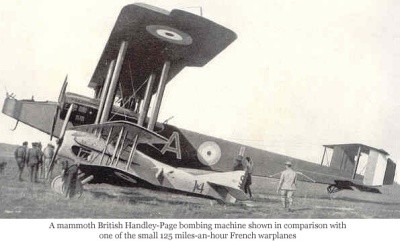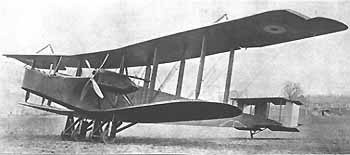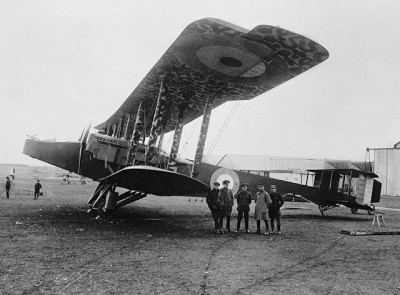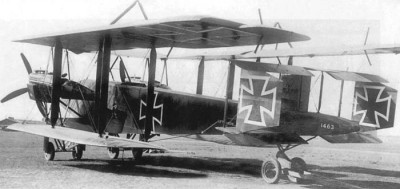| Název: Name: | Handley Page O/100 | Handley Page O/100 |
| Originální název: Original Name: | Handley Page O/100 | |
| Kategorie: Category: | bombardovací letoun | bomber aeroplane |
| Výrobce: Producer: | DD.MM.1915-DD.MM.1917 Handley Page Ltd, Cricklewood | |
| Období výroby: Production Period: | DD.MM.1915-DD.MM.1917 | |
| Vyrobeno kusů: Number of Produced: | 46 | |
| První vzlet: Maiden Flight: | 07.12.1915 | |
| Osádka: Crew: | 3 - 4 | |
| Základní charakteristika: Basic Characteristics: | ||
| Vzlet a přistání: Take-off and Landing: | CTOL - konvenční vzlet a přistání | CTOL - conventional take-off and landing |
| Uspořádání křídla: Arrangement of Wing: | dvouplošník | biplane |
| Uspořádání letounu: Aircraft Concept: | klasické | conventional |
| Podvozek: Undercarriage: | pevný | fixed |
| Přistávací zařízení: Landing Gear: | kola | wheels |
| Technické údaje: Technical Data: | ||
| Hmotnost prázdného letounu: Empty Weight: | 2530 kg | 5578 lb |
| Vzletová hmotnost: Take-off Weight: | 3629 kg | 8000 lb |
| Maximální vzletová hmotnost: Maximum Take-off Weight: | 6350 kg | 14000 lb |
| Rozpětí: Wingspan: | 30.48 m | 100ft |
| Délka: Length: | 19.16 m | 62ft 10.25in |
| Výška: Height: | 6.71 m | 22ft |
| Plocha křídla: Wing Area: | 153.1 m2 | 1648 ft2 |
| Plošné zatížení: Wing Loading: | ? kg/m2 | ? lb/ft2 |
| Pohon: Propulsion: | ||
| Kategorie: Category: | pístový | piston |
| Počet motorů: Number of Engines: | 2 | |
| Typ: Type: | Rolls-Royce Eagle II, 184 kW nebo Sunbeam Cossack, 239 kW čtyřlisté dřevěné vrtule | Rolls-Royce Eagle II, 260 hp or Sunbeam Cossack, 320 hp four-blade wooden propellers |
| Objem palivových nádrží: Fuel Tank Capacity: | ? | ? |
| Výkony: Performance: | ||
| Maximální rychlost: Maximum Speed: | 122.3 km/h v 0 m | 76 mph in 0 ft |
| Cestovní rychlost: Cruise Speed: | ? km/h v ? m | ? mph in ? ft |
| Rychlost stoupání: Climb Rate: | ? m/s | ? ft/min |
| Čas výstupu na výšku: Time to Climb to: | 19,67 min do 1524 m | 19,67 min to 5000 ft |
| Operační dostup: Service Ceiling: | 2652 m | 8700 ft |
| Dolet: Range: | ? km | ? mi |
| Maximální dolet: Maximum Range: | ? km | ? mi |
| Výzbroj: Armament: | 3-5 x kulomet Lewis 7,7 mm Pumy: 813 kg | 3-5 Lewis machine guns 1792 lb of bombs |
| Uživatelské státy: User States: | | |
| Poznámka: Note: | Vytrvalost 8 h Výstroj: standardní navigační přístroje, optický zaměřovač pum H.A.1a, optické zaměřovače kulometů | Endurance 8 hr |
| Zdroje: Sources: | CHANT, Chris. Nejslavnější bombardéry: Od roku 1914 do současnosti, Svojtka 2006, ISBN 80-7352-394-9 | |
Handley Page O/100
Handley Page O/100
At the beginning of the war, the British Admiralty initiated the development of several types to serve as patrol bombers and eventually attack German ports. Probably the most notable was the Wight AD 1, but none of these took off significantly. The Navy therefore decided to develop a true long-range bomber that would also help against the threat of German zeppelins by destroying their bases. The final impetus was a request by British Commander Samson, who was forced to face the German advance on Antwerp in 1914, for a "Bloody Paralyser", a bloody crippler (this name then became the unofficial nickname for the O/100 bomber). According to these, G. Volkert at Handley Page to develop his type, initially named Handley Page Type O and later O/100, where the number stood for the span in feet. Interestingly, the company referred to its types by the letters of the alphabet, but omitted the letter I so as not to confuse it with the numeral 1. The letter O was not omitted, causing occasional confusion by mistaking it for the numeral 0... When the prototype was completed, it was the largest machine ever made in England. It was a biplane with folding wings and an unequal span. The rectangular fuselage had twin tail surfaces, the undercarriage had twin wheels. The powerplant chosen (instead of the original Sunbeam) was a Rolls-Royce Eagle II engine of 184 kW, both engines were housed in armoured nacelles between the wings. This first prototype had a covered glass cockpit, which had armoured sides and floor. Meanwhile, as early as 9 February 1915, orders had been placed for the construction of eight production machines.
The prototype first flew on 7 December 1915 at Hendon and its performance was disappointing. Tests, carried out by RNAS pilots at Eastchurch, showed the machine to be too heavy, unstable and the tail surfaces suffered from severe vibration. The second prototype therefore had a redesigned extended nose, which opened up the two-seater cabin and space for a gunnery range, the engines were given new radiators and most of the heavy armour was removed. The tail surfaces were also heavily modified. This prototype was first tested in April 1916, and this time it showed a marked improvement. In early April, it even flew to an altitude of 2,100 metres with twenty company employees on board. This was the basis for the production machines. Only the fourth prototype carried armament, a 7.7mm Lewis machine gun on a Scarff ring in the forward gunnery range, the other two were behind the wings and operated by an observer. This one also had new engines, the Rolls-Royce Eagle III with 235 kW. Further experimentation with engines was then carried out on production machines, the fifteenth machine receiving Sunbeam Cossack engines of the same power, which were soon replaced by the lighter 191 kW RAF 3A engines. These were planned for other machines, but did not materialise.
In August 1916 the first operational squadron armed with these aircraft, the so-called Handley Page Squadron, was formed as part of the RNAS 3rd Wing and soon began operating in France. The first raid carried out by the Handley Page O/100 was on the night of 17 March 1917, during which a railway station near Metz was bombed. Meanwhile, the Germans had already had one machine in their hands since 1 January 1917, which landed due to a navigational error at the German field airfield near Laon. However, this machine was destroyed in a crash before flight trials began. At the end of June 1917, No. 3 Wing was disbanded and its machines were taken over by the Fifth Wing at Coudekerque for operations against U-boat bases at Bruges, Zeebrugge and Ostend. However, it was not until the 7th Squadron, 4th Wing RNAS, later renamed the 207th Squadron of the RAF, that the first unit fully equipped with these aircraft became operational. On 25 April 1917, four machines of this squadron sank a German destroyer, but one was shot down. From then on, therefore, Handley Page O/100s began flying at night. At least one machine of this squadron even served as a patrol against German Gotha bombers. On 29 September 1917, the crew of O/100 No 3134, piloted by FSL Gibbs with four gunners with five Lewis machine guns and eight 65lb bombs, spotted three German bombers during one of their four-hour patrol missions and attacked a pair of them. One of them, probably a Gotha G.IV 602/16, was shot down and made an emergency landing outside the Dutch border.
One O/100 made it to the Greek island of Mudros in May 1917, from where it bombed a German battleship Goeben in the Dardanelles and Turkish installations around Istanbul, conducting anti-submarine patrols. On 30 September 1917, this machine, piloted by later Atlantic conqueror John Alcock, had to land on the sea surface during a raid on Istanbul due to engine failure over the Gallipoli peninsula, and Alcock was then a Turkish prisoner of war for the rest of the war. Other units used by O/100 were 7A Squadron, later 14 Squadron RNAS (and from 1 April 1918 214 Squadron RAF) and 15 Squadron RAF. RNAS Squadron (from 1 April 1918 215th RAF Squadron).
Another machine with a different engine was one O/100, which was to be delivered to Russia. This one had FIAT A.12bis engines with 191 kW, but a crash and then the Russian Revolution prevented its delivery. In August and September 1917, the Davis recoilless gun was also tested on four machines. Six machines with Sunbeam Cossack engines were also built, but these were not used in combat, they were used to verify design changes for the production of an improved O/400 type and were actually an interim type. One of these was sent to the USA in January 1918 as a model for licensed production of the O/400. The 36th built O/100 was converted into a prototype of this version, the difference being mainly the installation of Eagle VIII engines and a different fuel system. Four machines even received four engines, Hispano Suiza 8s of 147 kW each, in tandem configuration, but this variant did not prove to be a sufficient improvement for series production. A total of 46 machines of all modifications were built, after which the type was replaced by the production O/400. In the new system introduced by the RAF in 1924, the O/100 was renamed H.P.11.
Source:
Hornat, Jiri: Handley Page O/100, L+K 18/1994
www.aviastar.org
http://www.airwar.ru/enc/bww1/hp100.html
http://www.handleypage.com/Aircraft_hp11.html
http://cs.wikipedia.org/wiki/Handley_Page_O/100
http://en.wikipedia.org/wiki/Handley_Page_Type_O
www.msim.org.uk
www.207squadron.rafinfo.org.uk
At the beginning of the war, the British Admiralty initiated the development of several types to serve as patrol bombers and eventually attack German ports. Probably the most notable was the Wight AD 1, but none of these took off significantly. The Navy therefore decided to develop a true long-range bomber that would also help against the threat of German zeppelins by destroying their bases. The final impetus was a request by British Commander Samson, who was forced to face the German advance on Antwerp in 1914, for a "Bloody Paralyser", a bloody crippler (this name then became the unofficial nickname for the O/100 bomber). According to these, G. Volkert at Handley Page to develop his type, initially named Handley Page Type O and later O/100, where the number stood for the span in feet. Interestingly, the company referred to its types by the letters of the alphabet, but omitted the letter I so as not to confuse it with the numeral 1. The letter O was not omitted, causing occasional confusion by mistaking it for the numeral 0... When the prototype was completed, it was the largest machine ever made in England. It was a biplane with folding wings and an unequal span. The rectangular fuselage had twin tail surfaces, the undercarriage had twin wheels. The powerplant chosen (instead of the original Sunbeam) was a Rolls-Royce Eagle II engine of 184 kW, both engines were housed in armoured nacelles between the wings. This first prototype had a covered glass cockpit, which had armoured sides and floor. Meanwhile, as early as 9 February 1915, orders had been placed for the construction of eight production machines.
The prototype first flew on 7 December 1915 at Hendon and its performance was disappointing. Tests, carried out by RNAS pilots at Eastchurch, showed the machine to be too heavy, unstable and the tail surfaces suffered from severe vibration. The second prototype therefore had a redesigned extended nose, which opened up the two-seater cabin and space for a gunnery range, the engines were given new radiators and most of the heavy armour was removed. The tail surfaces were also heavily modified. This prototype was first tested in April 1916, and this time it showed a marked improvement. In early April, it even flew to an altitude of 2,100 metres with twenty company employees on board. This was the basis for the production machines. Only the fourth prototype carried armament, a 7.7mm Lewis machine gun on a Scarff ring in the forward gunnery range, the other two were behind the wings and operated by an observer. This one also had new engines, the Rolls-Royce Eagle III with 235 kW. Further experimentation with engines was then carried out on production machines, the fifteenth machine receiving Sunbeam Cossack engines of the same power, which were soon replaced by the lighter 191 kW RAF 3A engines. These were planned for other machines, but did not materialise.
In August 1916 the first operational squadron armed with these aircraft, the so-called Handley Page Squadron, was formed as part of the RNAS 3rd Wing and soon began operating in France. The first raid carried out by the Handley Page O/100 was on the night of 17 March 1917, during which a railway station near Metz was bombed. Meanwhile, the Germans had already had one machine in their hands since 1 January 1917, which landed due to a navigational error at the German field airfield near Laon. However, this machine was destroyed in a crash before flight trials began. At the end of June 1917, No. 3 Wing was disbanded and its machines were taken over by the Fifth Wing at Coudekerque for operations against U-boat bases at Bruges, Zeebrugge and Ostend. However, it was not until the 7th Squadron, 4th Wing RNAS, later renamed the 207th Squadron of the RAF, that the first unit fully equipped with these aircraft became operational. On 25 April 1917, four machines of this squadron sank a German destroyer, but one was shot down. From then on, therefore, Handley Page O/100s began flying at night. At least one machine of this squadron even served as a patrol against German Gotha bombers. On 29 September 1917, the crew of O/100 No 3134, piloted by FSL Gibbs with four gunners with five Lewis machine guns and eight 65lb bombs, spotted three German bombers during one of their four-hour patrol missions and attacked a pair of them. One of them, probably a Gotha G.IV 602/16, was shot down and made an emergency landing outside the Dutch border.
One O/100 made it to the Greek island of Mudros in May 1917, from where it bombed a German battleship Goeben in the Dardanelles and Turkish installations around Istanbul, conducting anti-submarine patrols. On 30 September 1917, this machine, piloted by later Atlantic conqueror John Alcock, had to land on the sea surface during a raid on Istanbul due to engine failure over the Gallipoli peninsula, and Alcock was then a Turkish prisoner of war for the rest of the war. Other units used by O/100 were 7A Squadron, later 14 Squadron RNAS (and from 1 April 1918 214 Squadron RAF) and 15 Squadron RAF. RNAS Squadron (from 1 April 1918 215th RAF Squadron).
Another machine with a different engine was one O/100, which was to be delivered to Russia. This one had FIAT A.12bis engines with 191 kW, but a crash and then the Russian Revolution prevented its delivery. In August and September 1917, the Davis recoilless gun was also tested on four machines. Six machines with Sunbeam Cossack engines were also built, but these were not used in combat, they were used to verify design changes for the production of an improved O/400 type and were actually an interim type. One of these was sent to the USA in January 1918 as a model for licensed production of the O/400. The 36th built O/100 was converted into a prototype of this version, the difference being mainly the installation of Eagle VIII engines and a different fuel system. Four machines even received four engines, Hispano Suiza 8s of 147 kW each, in tandem configuration, but this variant did not prove to be a sufficient improvement for series production. A total of 46 machines of all modifications were built, after which the type was replaced by the production O/400. In the new system introduced by the RAF in 1924, the O/100 was renamed H.P.11.
Source:
Hornat, Jiri: Handley Page O/100, L+K 18/1994
www.aviastar.org
http://www.airwar.ru/enc/bww1/hp100.html
http://www.handleypage.com/Aircraft_hp11.html
http://cs.wikipedia.org/wiki/Handley_Page_O/100
http://en.wikipedia.org/wiki/Handley_Page_Type_O
www.msim.org.uk
www.207squadron.rafinfo.org.uk
Reklama
Photos taken from www.earlyaviator.com.
Porovnání velikosti se stíhačkou Spad VII.
| Period | - |
| Producer | - |
| Type | - |
| Camouflage | - |
| Country | - |
| Pilot | - |
| Production No. | - |
| Serial No. / Evidence No. | - |
| Tactical Marking / Imatriculation | - |
| Name | - |
| Unit | - |
| Base | - |
| Date (DD.MM.RRRR) | - |
| Author | - |
| Print size / 300 DPI | - |
| Published with authors permit | - |
| Author Website | - |
Porovnání velikosti se stíhačkou Spad VII.
| Period | - |
| Producer | - |
| Type | - |
| Camouflage | - |
| Country | - |
| Pilot | - |
| Production No. | - |
| Serial No. / Evidence No. | - |
| Tactical Marking / Imatriculation | - |
| Name | - |
| Unit | - |
| Base | - |
| Date (DD.MM.RRRR) | - |
| Author | - |
| Print size / 300 DPI | - |
| Published with authors permit | - |
| Author Website | - |
en.wikipedia.org
.| Period | World War One / The Great War [1914-1918] |
| Producer | Handley Page |
| Type | Handley Page O/100 |
| Camouflage | Standardní vojenská |
 Zelená tmavá / Dark Green Zelená tmavá / Dark Green Plátno / Fabric Plátno / Fabric |
|
| Country |  |
| Pilot | - |
| Production No. | - |
| Serial No. / Evidence No. | 1459 |
| Tactical Marking / Imatriculation | - |
| Name | - |
| Unit | - |
| Base | Baudoncourt, Letiště Luxeuil [1912-1930] |
| Date (DD.MM.RRRR) | DD.03.1917 |
| Author | - |
| Print size / 300 DPI | - |
| Published with authors permit | - |
| Author Website | - |
1459, první O/100 přidělený operační jednotce, 3. křídlu RNAS. V noci z 16.na 17. března 1917 provedl nálet na železniční stanici u Mét.
http://www.airwar.ru/enc/bww1/hp100.html
.| Period | World War One / The Great War [1914-1918] |
| Producer | Handley Page |
| Type | Handley Page O/100 |
| Camouflage | Kořistní |
 Zelená tmavá / Dark Green Zelená tmavá / Dark Green |
|
| Country |  |
| Pilot | - |
| Production No. | - |
| Serial No. / Evidence No. | 1463 |
| Tactical Marking / Imatriculation | - |
| Name | - |
| Unit | - |
| Base | - |
| Date (DD.MM.RRRR) | DD.MM.RRRR |
| Author | - |
| Print size / 300 DPI | - |
| Published with authors permit | - |
| Author Website | - |
1. ledna 1917 při přeletu na letiště v Luxeil poručík H. C. Vecker s novým O/100 1463 zabloudil nad Němci držené území a nouzově přistál v Chalandry. Němci neporušený letoun poslali do Johannisthalu, byl ale zničen při nehodě dříve, než mohl být pořádně prozkoumán.
Reklama
Join us
We believe that there are people with different interests and experiences who could contribute their knowledge and ideas. If you love military history and have experience in historical research, writing articles, editing text, moderating, creating images, graphics or videos, or simply have a desire to contribute to our unique system, you can join us and help us create content that will be interesting and beneficial to other readers.
Find out more


